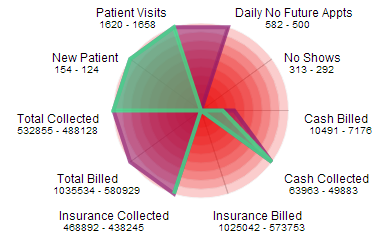Monitor Your Chiropractic Practice Health at a Glance

Watch Your Chiropractic Practice Health and Get Back To Your Patients Faster Control your Chiropractic Practice Health! Chiropractic Practices rely on separate reports to understand where they are as a practice and a business. Separate reports require comparison and compilation in Excel or other spreadsheets to stack data and notice a trend over time. Comparison of rows of numbers is difficult without graphics to show trends. Imagine never pulling numbers out of reports to compare where you are and where your business is going. Imagine having a tool that enables you to track your daily business goals at a glance. Imagine the time savings that you can now spend with your patients. Well, imagine no more. The tool is called The Genesis Chiropractic Practice Health Monitor and you can learn about it in this 15 minute webinar.
Prevent Chiropractic Compliance Failure

Three Key Practice Compliance Skills in a Genesis Training Webinar Compliance with laws and regulations is very important. Practice Owners and Management Staff regularly have questions about how to maintain a compliant practice, including patient visit documentation. How can you keep up with changing regulations and multiple participants when you have a lack of knowledge and a lack of time? Watch this free webinar to learn more. Read the transcript: Reuven: Hey, everyone, and welcome to our webinar today on “The Secrets to Prevent Compliance Failure.” Compliance, obviously, is one of the biggest things that preys on practices today especially in the physical health realm. Whether you’re a chiropractor, physical therapist, mental health, it really doesn’t matter. Across the whole spectrum, you know, you see these situations where compliance becomes a real problem. And so when we talk today, we’re gonna get to the root cause of the problem. We’re gonna talk about, what is so important when it comes to compliance and how is it that our solution really helps you to prevent issues with compliance? And in order to do that, we’re gonna talk about obviously, why that problem is important, why compliance is important. We’re also gonna talk about why compliance is so difficult. You know, one of the biggest questions we get asked on a regular basis is why can’t this just be super easy? And there are solutions out there that will try to do that for you, but often times, they won’t do it in a compliant way, and so you end up being faster but less compliant which, in the end, is not good for your practice. So the real question is how do you maintain a compliant practice? You know, and that includes your documentation. And really, the question becomes more specific in that you have to maintain compliance in spite of things like changing regulations and, of course, we talk about how regulations will change starting with the federal level, with Medicare, and then Blue Cross Blue Shield, and then out to the rest of the commercial insurances, and then, of course, then to the state boards. And the next issue is with multiple participants, you know, different people that have their hands, that have their fingers in different pies and, of course, obviously, a lack of time, you know, with regards to just how much time you can spend. You know, it’s easy to say that if you had an hour per document that you could be super compliant without even using a system, but it’s really not practical. And the other side of it is that as a clinician, you know, we’re really trained to treat patients, not treat, you know, a healthcare system that requires so much of us. And so this lack of knowledge becomes a real debilitating situation to the point where, you know, there’s an entire industry surrounding compliance outside of solutions like ours where, you know, practices will spend lots and lots of money to make sure that they can avoid losing a lot more money. And so this problem really is really big and really complex and, you know, what we’re gonna try to do today is really simplify that problem and make it easier to understand and easier to solve. So the next question is why is it important? And that really comes down to a few things, and the first one is, in the course of running a practice, you know, there’s always gonna be an expected rate of error. So this is a really basic idea. No matter what you are doing, there’s always going to be mistakes that are made, and that’s just a factor of being human. And a lot of people say, “Well, if you automate it all, then you get rid of mistakes.” And what we find actually is, in technology, there’s also an expected rate of error. For example, you know, any of you, Windows users, will remember when the new version of Windows comes out, there are always issues with it, and so, they always have to update it, and you always have to download these Windows’ updates. And we find the same thing with Apple. Everybody remembers the big debacle with…I think it was Apple iOS 5 or 6 where, you know, things just started crashing on devices like iPads. And so what we find is that there’s always a percentage of error especially when you have people, especially when you have technology, but especially when you have both working together. And so it’s not a matter of saying, “All right, well, I expect errors which means that I’m kind of at a loss to begin with,” it’s more a matter of, “Okay, I understand that there’s a problem, the next question is how do I address that problem?” So we wanna understand that, of course, any errors can result in costly penalties, we wanna be aware of the effect of our mistakes so that we can focus on ways to minimize them. So the next question really becomes why is it so difficult to solve? And so with so many moving parts in a practice, you know, you’re dealing with yourself as an owner or yourself as a front office practice manager, whatever it is you’re doing, but you have practitioners, you have front office staff, you have practice managers or office managers, you have the patients, which are the most moving part in your office, you know, and then, of course, you have all the supporting things like the solution that you’re using or anything like that. So you have lots and lots of moving parts with different people, some of which have different processes and, really, that are relying on different technologies. And so take all of that and then add the complexity of a constantly changing environment with regulations. And, of course, knowing that you might have different sets of regulations because Medicare might have changed things before
The Secret to Understanding Chiropractic Practice Cashflow

Obviously, Cashflow will help your Practice grow! On Cashflow: Practice owners and staff regularly have questions about where their payments are, how they can see which insurance companies are helping them, and/or which patients are struggling to pay their bills. Fortunately, with a single report, practices can now periodically review where their payments are and how well their office is functioning, while comparing the metrics that are most important to their success. Watch this free webinar to learn more.
Improving Practice Workflow and Accountability

How can Dr. Ben improve workflow and accountability in his chiropractic practice? Ben smiled reassuringly at his patient, snapped the file closed, and headed to the office. “I think I might need a translator for this patient,” he said. “Of course, Dr. Ben,” Pam assured him, picking up her phone. Ben headed back down the hall with long strides, but when he had finished with the patient, he returned to talk with his office manager. “So, Pam,” he began — and then stopped while she answered a phone call and handed a clipboard of forms to a new patient. “Sorry about that,” Pam smiled. “What can I do for you?” Ben lowered his voice. “Would you say things are going smoothly in the office? I noticed that you were able to provide a translator immediately and it looks as though you have everything under control.” “I pride myself on looking like I have everything under control,” Pam assured him. “And mostly I do, even if sometimes I’m like a duck.” “A duck?” “Gliding along the water on top and paddling like crazy underneath,” Pam laughed. “Seriously, I think things are going pretty well. We have issues. What chiropractic practice doesn’t? But overall it’s good.” “What issues do you see?” Ben pursued the question. “Sometimes we have to search pretty hard to find the information we want,” Pam said promptly. “I’m still waiting for that new software we’ve been talking about.” Ben nodded. “I just haven’t gotten around to it.” “And it would help a lot if staff could really know what their daily workload was going to be. Everyone just comes in and waits for me to tell them what to do. If I don’t have time to tell them anything, they don’t do anything.” Pam’s eyes widened. “I think they’d rather be able to take ownership of their work and get the satisfaction of accomplishing things and being part of the team instead of just hanging around in case they’re needed, but the work just isn’t set up that way.” “The work just doesn’t happen that way,” Ben said. Pam’s face alerted him that he had raised his voice and he lowered it again. “Like the translator — we don’t know ahead of time when we’re going to need him.” Pam looked doubtful. “I’m not so sure that’s true. I mean, it’s not like Mrs. Vargas suddenly didn’t understand. Maybe we should have a note in her file. Maybe we should ask people when we make the appointment. Maybe we could even cluster the appointments of people who might need a particular translator.” Ben frowned. “I feel like we’re getting off track here. Isn’t this just one little thing?” “Yes,” Pam agreed, “but every day is made up of those little things. We do some stop gap thing to solve a problem and after a while it becomes what we do. It’s hard to hold people accountable when they never know what they’ll be accountable for.” “I see your point,” Ben said. “It’s like what my wife calls ‘workflow.’ You’re telling me the work isn’t exactly flowing.” Pam smiled. “I’m not sure that’s what workflow means, exactly, but yes, I guess that’s another way of saying we’re just paddling like crazy under the water.” Disclaimer: For HIPAA compliance, all characters appearing in this post are fictitious. Any resemblance to actual persons or actual events is purely coincidental.

